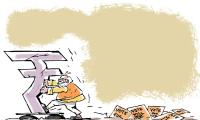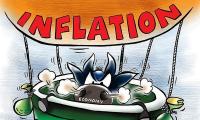India's Economy Resilient Despite Shocks: RBI MPC Member
RBI MPC member Ashima Goyal highlights India's economic resilience despite global shocks and advocates for counter-cyclical policies to maintain stability.

Photograph: ANI Photo
New Delhi, Mar 1 (PTI) The Indian economy has done well despite multiple external shocks, but counter-cyclical macroeconomic policy measures will be required to aid the economy's natural resilience as geopolitical situation remains fragile, RBI's Monetary Policy Committee (MPC) member Ashima Goyal said on Friday.
Goyal in an interview with PTI further said inflation in the country has come down but it has not yet reached the target levels.
"Major contributing factors for good performance were India's rising economic diversity and the role of policy in smoothing shocks.
"Both these helped India do well despite multiple external shocks," she said.
The Reserve Bank has projected GDP growth for the next financial year at 7 per cent on the back of improved household consumption and upturn in the private capex cycle.
"Since geopolitics continues to be fragile, counter-cyclical policy must continue to aid the economy's natural resilience," the eminent economist added.
Noting that the government has over-achieved its fiscal deficit target despite nominal income growth being less than what projected in the budget (since wholesale prices fell), she said higher growth and tax buoyancy gives room to reduce deficit and debt ratios while adequately raising absolute amounts of spending.
According to her, the temptation to spend excessively as revenues rise should be avoided as this was the mistake made in the high growth period of the 2000s and led to a decade of macroeconomic fragility.
"It is much better for spending to be counter-cyclical, build buffers and space in good times to be able to spend in bad times," Goyal emphasised.
To a question on inflation, interest rate cuts by central banks around the world will be gradual in order to keep real rates at levels required for acceptable inflation and growth "For this, nominal policy rates will have to come down in line with sustainable falls in inflation," she said.
The retail inflation, which the RBI mainly factors in while deciding its bi-monthly monetary policy, is inching towards its target of 4 per cent, with the January imprint at 5.1 per cent.
Recently, RBI Governor Shaktikanta Das had also said that the central bank's job to bring down inflation is not over, and any premature move on the policy front could undermine the success achieved so far on the price situation.
Accordingly, RBI's rate setting panel MPC earlier this month had decided to leave the key policy rate unchanged at 6.5 per cent for the sixth time in a row. It is almost a year now that the repo rate or short-term borrowing rate is at 6.5 per cent.
Responding to a question on the debate of economically and socially better-off southern and western states 'subsidising' the northern and eastern states, Goyal opined that net transfers are part of a fiscal federation and help make the country a viable entity.
"The direction of transfers was different in the past and will change again in the future as other states also develop.
"But states gain much more from being part of India than just resource transfers," she emphasised.
Noting that there are many advantages of being part of a large and growing country, "Goyal said, "We are surrounded by challenges and have survived and now are thriving because we are together." The government has recently constituted the commission under the chairmanship of eminent economist Arvind Panagariya.
Besides suggesting tax devolution between the Centre and states and revenue augmentation measures, the commission would review the present arrangements for financing disaster management initiatives with reference to the funds constituted under the Disaster Management Act, 2005.
To a question on why rural wages adjusted for inflation have barely risen over the past decade, Goyal pointed out that many rural wage-earning households receive free food and benefit from other schemes so their real effective wage growth is higher.
She further explained that in the 2010s real rural wage growth was in double digits because food inflation was high but wage growth in turn led to high and persistent inflation.
"In an inflation targeting regime, real wage growth cannot exceed productivity growth," Goyal said, adding that nominal wages can grow at this plus the 4 per cent inflation target.
While noting that rural incomes can rise sustainably as productivity rises and with greater availability of and migration to more productive jobs, she said, "this is building-up slowly". In 2004-05, the average rural worker earned an adjusted USD 3 per day, that jumped to USD 4.80 by the time Narendra Modi took over as Prime Minister and has remained flat ever since.
Asked about the top reforms she would like to see in the next five years, Goyal noted that she would like to see reduction in judicial and regulatory delays; more devolution of funds and functionaries to the 3rd tier urban local bodies and panchayats among others.
"The typical factor market reforms that foreign investors want create political resistance and are best left to competition at the state level," she said.
Goyal also suggested that the Centre should create first loss funds that can attract large private investment flows in electricity distribution areas that are deterred at present by high initial risk.
"States that are able to reform their electricity distribution will be able to attract large inflows coming in for renewable energy," she said.
Goyal in an interview with PTI further said inflation in the country has come down but it has not yet reached the target levels.
"Major contributing factors for good performance were India's rising economic diversity and the role of policy in smoothing shocks.
"Both these helped India do well despite multiple external shocks," she said.
The Reserve Bank has projected GDP growth for the next financial year at 7 per cent on the back of improved household consumption and upturn in the private capex cycle.
"Since geopolitics continues to be fragile, counter-cyclical policy must continue to aid the economy's natural resilience," the eminent economist added.
Noting that the government has over-achieved its fiscal deficit target despite nominal income growth being less than what projected in the budget (since wholesale prices fell), she said higher growth and tax buoyancy gives room to reduce deficit and debt ratios while adequately raising absolute amounts of spending.
According to her, the temptation to spend excessively as revenues rise should be avoided as this was the mistake made in the high growth period of the 2000s and led to a decade of macroeconomic fragility.
"It is much better for spending to be counter-cyclical, build buffers and space in good times to be able to spend in bad times," Goyal emphasised.
To a question on inflation, interest rate cuts by central banks around the world will be gradual in order to keep real rates at levels required for acceptable inflation and growth "For this, nominal policy rates will have to come down in line with sustainable falls in inflation," she said.
The retail inflation, which the RBI mainly factors in while deciding its bi-monthly monetary policy, is inching towards its target of 4 per cent, with the January imprint at 5.1 per cent.
Recently, RBI Governor Shaktikanta Das had also said that the central bank's job to bring down inflation is not over, and any premature move on the policy front could undermine the success achieved so far on the price situation.
Accordingly, RBI's rate setting panel MPC earlier this month had decided to leave the key policy rate unchanged at 6.5 per cent for the sixth time in a row. It is almost a year now that the repo rate or short-term borrowing rate is at 6.5 per cent.
Responding to a question on the debate of economically and socially better-off southern and western states 'subsidising' the northern and eastern states, Goyal opined that net transfers are part of a fiscal federation and help make the country a viable entity.
"The direction of transfers was different in the past and will change again in the future as other states also develop.
"But states gain much more from being part of India than just resource transfers," she emphasised.
Noting that there are many advantages of being part of a large and growing country, "Goyal said, "We are surrounded by challenges and have survived and now are thriving because we are together." The government has recently constituted the commission under the chairmanship of eminent economist Arvind Panagariya.
Besides suggesting tax devolution between the Centre and states and revenue augmentation measures, the commission would review the present arrangements for financing disaster management initiatives with reference to the funds constituted under the Disaster Management Act, 2005.
To a question on why rural wages adjusted for inflation have barely risen over the past decade, Goyal pointed out that many rural wage-earning households receive free food and benefit from other schemes so their real effective wage growth is higher.
She further explained that in the 2010s real rural wage growth was in double digits because food inflation was high but wage growth in turn led to high and persistent inflation.
"In an inflation targeting regime, real wage growth cannot exceed productivity growth," Goyal said, adding that nominal wages can grow at this plus the 4 per cent inflation target.
While noting that rural incomes can rise sustainably as productivity rises and with greater availability of and migration to more productive jobs, she said, "this is building-up slowly". In 2004-05, the average rural worker earned an adjusted USD 3 per day, that jumped to USD 4.80 by the time Narendra Modi took over as Prime Minister and has remained flat ever since.
Asked about the top reforms she would like to see in the next five years, Goyal noted that she would like to see reduction in judicial and regulatory delays; more devolution of funds and functionaries to the 3rd tier urban local bodies and panchayats among others.
"The typical factor market reforms that foreign investors want create political resistance and are best left to competition at the state level," she said.
Goyal also suggested that the Centre should create first loss funds that can attract large private investment flows in electricity distribution areas that are deterred at present by high initial risk.
"States that are able to reform their electricity distribution will be able to attract large inflows coming in for renewable energy," she said.
You May Like To Read
TODAY'S MOST TRADED COMPANIES
- Company Name
- Price
- Volume
- Vodafone-Idea-L
- 11.65 (+ 3.56)
- 106772451
- Alstone-Textiles
- 0.28 ( -3.45)
- 44187760
- Mangalam-Industrial
- 0.88 ( -2.22)
- 39177573
- Sunshine-Capital
- 0.27 (+ 3.85)
- 35956340
- GMR-Airports
- 104.40 (+ 6.37)
- 30453005






